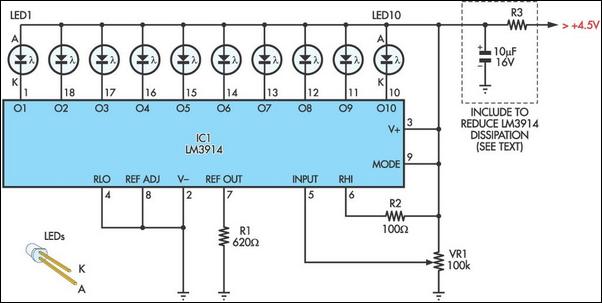Home » Circuits
Novel White LED Torch
Although this design is reproduced directly from the manufacturer’s datasheets, its use in this application is rather novel. Originally intended for high-visibility LED bargraph readouts, here the LM3914 is used as the basis of a 10-step variable brightness current-regulated white LED torch! The circuit has only four components in the control and regulation circuit: R1, R2, VR1 and the LM3914. The circuit can be built directly on the pins of the LM3914 to produce a package not much bigger than the LM3914 itself. The LM3914 is set to operate in bargraph mode so that the LEDs light progressively as its input signal increases.This signal comes from the wiper of VR1, which provides a variable voltage between 0V and the supply voltage to pin 5 of the LM3914. The internal resistor ladder network of the LM3914 has its low end (pin 4) connected to ground and the high end (pin 6) connected to the supply voltage via R2. The purpose of R2 is to give LED 10 a clear turn-on zone. Resistor R1 (620Ω) on pin 7 of IC1 sets the current through each LED to about 20mA. As VR1 is rotated from the 0V position (all LEDs off) to the supply voltage position (all LEDs on), the LEDs will progressively light. With all LEDs off, the circuit will draw about 5mA. With all LEDs illuminated, it will draw about 205mA and dissipate 307mW with a 4.5V supply.
Circuit diagram: Editors note:
These are nominal figures only. Actual device dissipation will depend entirely on the input voltage and LED forward voltage. In use, we recommend that a resistor (R3) be inserted in series with the positive supply, chosen so that the LM3914’s dissipation is limited to about 500mW. Typically, this would be needed for supply voltages of 6V and higher. The inclusion of the resistor necessitates a 10μF decoupling capacitor across the supply rails.)
By carefully selecting the LEDs, this torch can be as bright as 15,0000mCd while costing less than $20.
Author: Mick Stuart - Copyright: Silicon Chip Electronics

